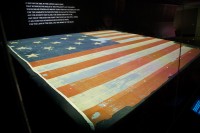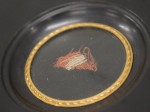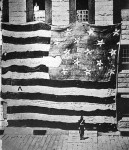 Sunday, Saturday 14th, is the 200th anniversary of Francis Scott Key’s penning of the poem that would become the national anthem of the United States. Fort McHenry, target of the British bombardment during the Battle of Baltimore that inspired Key’s poem, is hosting a panoply of commemorative events this weekend, culminating in the Dawn’s Early Light Flag-Raising Ceremony at 8:30 Sunday morning. The historically accurate replica of Mary Pickersgill’s flag made by Maryland Historical Society volunteers last year will be hoisted at the ceremony, a stand-in for the original flag. If you’re not going to be in Baltimore this weekend, you can enjoy some of the rockets’ red glare, air shows, flag-raising and fireworks via webcam.
Sunday, Saturday 14th, is the 200th anniversary of Francis Scott Key’s penning of the poem that would become the national anthem of the United States. Fort McHenry, target of the British bombardment during the Battle of Baltimore that inspired Key’s poem, is hosting a panoply of commemorative events this weekend, culminating in the Dawn’s Early Light Flag-Raising Ceremony at 8:30 Sunday morning. The historically accurate replica of Mary Pickersgill’s flag made by Maryland Historical Society volunteers last year will be hoisted at the ceremony, a stand-in for the original flag. If you’re not going to be in Baltimore this weekend, you can enjoy some of the rockets’ red glare, air shows, flag-raising and fireworks via webcam.
 The original Star-Spangled Banner is in the Smithsonian’s National Museum of American History. It’s so delicate it is kept in perpetual semi-darkness (no more than one foot-candle of light) in a custom display case that cost $30 million dollars to make. The two-storey chamber is climate controlled and keeps the flag free of oxygen and vibrations. The flag is angled at 10 degrees, enough so people can view it without subjecting the banner to the drag of gravity.
The original Star-Spangled Banner is in the Smithsonian’s National Museum of American History. It’s so delicate it is kept in perpetual semi-darkness (no more than one foot-candle of light) in a custom display case that cost $30 million dollars to make. The two-storey chamber is climate controlled and keeps the flag free of oxygen and vibrations. The flag is angled at 10 degrees, enough so people can view it without subjecting the banner to the drag of gravity.
 One of the reasons the flag is in such a delicate condition is that for years people snipped off souvenirs from it. The Smithsonian has a number of snippets in storage, including a red and white fragment that was once on display at the U.S. Naval Academy Museum in Annapolis, Maryland. Other fragments may be out there in the hands of people who don’t know what they have. The Smithsonian can examine these fragments to help identify them.
One of the reasons the flag is in such a delicate condition is that for years people snipped off souvenirs from it. The Smithsonian has a number of snippets in storage, including a red and white fragment that was once on display at the U.S. Naval Academy Museum in Annapolis, Maryland. Other fragments may be out there in the hands of people who don’t know what they have. The Smithsonian can examine these fragments to help identify them.
With Maryland celebrating its Defenders’ Day on Friday and America’s victory over the British 200 years ago Sunday, at least two families recently inquired whether their fragments might have historical value.
Museum conservators are using microscopes, x-rays and other equipment to analyze their weaves, stains and soils to see if they match. Family histories and documents also help prove provenance.
Since the flag came to the Smithsonian in 1907, about 17 pieces have been donated or bought at auction. The museum last acquired pieces in 2003 but has no plans to try to recover them all or reattach them to the original flag.
 It would be impossible to reattach most of the pieces. How could you tell where a postage-stamp sized piece of white, for example, originally fit on the flag? Curators would love to see one particular fragment reappear, however. There were 15 stars on the flag when Mary Pickersgill’s team made the flag. One of them was cut out before June 21st, 1873 when the flag was photographed on display at the Boston Navy Yard.
It would be impossible to reattach most of the pieces. How could you tell where a postage-stamp sized piece of white, for example, originally fit on the flag? Curators would love to see one particular fragment reappear, however. There were 15 stars on the flag when Mary Pickersgill’s team made the flag. One of them was cut out before June 21st, 1873 when the flag was photographed on display at the Boston Navy Yard.
“We’d love to have that back,” said the flag’s chief conservator Suzanne Thomassen-Krauss. “That one I might put back on.”